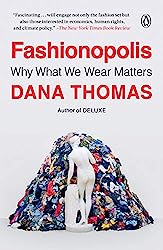
Rating: 7.4/10.
Fashionopolis: Why What We Wear Matters by Dana Thomas
Book about fast fashion and its negative effects. We are used to buying a lot of cheap clothes without thinking too much, but fast fashion has a lot of negative effects on the environment and workers in developing countries. Fashion is very fast-paced and cheap to produce, giving profits to those who manage the process. At the top end are designer fashion shows; most people buy mid-tier brands that quickly imitate designer brands, looking at which styles are gaining traction and produce similar styles at a more affordable price. These brands put their products in stores and iterate quickly, for example, Zara determines within a week whether or not an item is selling well, and if not, remove it from the store.
The clothing industry has historically not treated its workers very well, but today this has worsened, since much of clothing production today takes place in Bangladesh, where working conditions are particularly bad. There have been many deaths due to fires and building collapses and workers being trapped in clothing factories during fires (owners often locked the doors to prevent theft). One of the most devastating incidents was the collapse of Rana Plaza in Dhaka in 2013, killing hundreds of workers. Western companies, who are the customers, try to deflect responsibility and claim ignorance about the poor working conditions. After the Rana Plaza incident, conditions have improved somewhat and building codes have gotten stricter, albeit to a limited extent.
The clothing industry also causes environmental damage: especially in jeans production which involves several environmentally degrading processes. Washing the jeans consumes a large amount of water that is often discharged into rivers without proper treatment. Furthermore, the finishing process exposes workers to textile dust when they spend long hours performing the task and inhaling particles. In the 1990s, Levi’s laid off thousands of domestic workers and relocated to countries with cheaper labor.
The first third of the book is about issues in the fashion industry, while the remaining two thirds is about efforts to bring clothing production back to domestically. Although domestic manufacturing exists, this industry is relatively niche and small scale: for example, made-to-order businesses that take orders and hire local sewers to do the work in a few days and ship it out. However, the main challenge is the cost with paying American wages, and the resulting cost is an order of magnitude higher than most most people can afford, a dress that would typically cost \$100 would cost around $3000 if produced domestically. Therefore, the domestic clothing manufacturing industry remains relatively niche.
Overall, I thought the first part of the book was good, but I became bored after a few chapters of the second part, which tells many stories of domestic clothing production businesses. The author seemed overly optimistic about the benefits of domestic manufacturing, and doesn’t address the structural economic problems of domestic production. The book does acknowledge that the domestic industry is very small compared to the wider fashion industry, primarily due to cost constraints, and the efforts of these entrepreneurs is commendable but their market share is pitifully small, so the author’s enthusiastic portrayal of them feels out of touch with reality.



